
Cover art by Al Hartley
Patsy Walker is a comic book title featuring the character Patsy Walker originally published by Timely Comics beginning in 1945, by Atlas Comics from 1951 to 1961, and later by Marvel Comics.

Patsy Walker is a comic book title featuring the character Patsy Walker originally published by Timely Comics beginning in 1945, by Atlas Comics from 1951 to 1961, and later by Marvel Comics.
Created by writer Stuart Little and artist Ruth Atkinson, Patsy Walker first appeared in Miss America Magazine #2 (cover-dated November 1944), published by Marvel precursor Timely Comics. [1] [2] Redheaded Patsy Walker, her parents Stanley and Betty, her boyfriend Robert "Buzz" Baxter, and her raven-haired friendly rival Hedy Wolfe appeared from the 1940s through 1967 in issues of Miss America, Teen Comics, Girls' Life, and the namesake teen-humor series Patsy Walker, [3] [4] as well as in the spin-offs Patsy and Hedy , [5] Patsy and Her Pals, [6] and the single-issue A Date with Patsy. [7] Attesting to its quiet popularity, Patsy Walker (along with Millie the Model and Kid Colt, Outlaw ) was among the very few titles published continuously by Marvel from the 1940s Golden Age of Comic Books, through Marvel's 1950s iteration as Atlas Comics, and into the 1960s Silver Age of Comic Books. [8] [9]
The first issue was published in 1945, and was published by Timely Comics until issue #36 (September 1951), while Atlas Comics continued the publication from #37 (November 1951) through #94 (April 1961), and Marvel Comics continued the publication beginning with issue #95 (June 1961).
Future Mad magazine cartoonist and Mad Fold-in creator Al Jaffee wrote and drew most of the early issues of Patsy Walker, [10] [11] several of which included Mad founding editor Harvey Kurtzman's highly stylized "Hey Look!" one-page humor strips. [12] [13] [14] [15] Jaffee was succeeded by Al Hartley, who went to Archie Comics and produced many Christian comic books starring Archie characters and others. [16]
The high-school series Patsy Walker, co-created by Atkinson and writer Otto Binder in 1944, [17] featured art by Al Hartley, Al Jaffee, Morris Weiss and others, and ran until 1967. [18]
As Timely segued into Atlas Comics, Marvel's 1950s predecessor, Al Hartley made his mark with a more than decade-long run on the Patsy Walker teen-girl titles. With writer-editor Stan Lee, Hartley chronicled the redheaded high schooler's lightly comic adventures in her namesake series (which ran through 1964) and in its spin-offs, Patsy and Hedy (which ran through 1967) and the single-issue A Date with Patsy (Sept. 1957). Well into the Marvel era, Hartley also drew the "Special Queen Size Annual" publication Patsy Walker's Fashion Parade #1 (1966). [19]
The last comic to bear the Atlas globe on the cover was the comic Dippy Duck #1, [20] and the first to bear the new "Ind." distributors' mark was Patsy Walker #73, both cover-dated October 1957. [21]
Patsy Walker #95 – together with the science-fiction anthology Journey into Mystery #69 (both June 1961) – are the first modern comic books labeled "Marvel Comics", with each showing an "MC" box on its cover. [22]
Following Patsy's high-school graduation in issue #116 (Aug. 1964), the title switched from humor to become a young career-gal romantic adventure. [23] Patsy Walker lasted through issue #124 (Dec. 1965), [24] with Patsy and Hedy outlasting it to its own #110 (Feb. 1967). [25]
Writer Steve Englehart later introduced the concept of Walker as a superhero in the Beast feature in Amazing Adventures #13 (July 1972). [26] Englehart recalled that Walker's cameo in Fantastic Four Annual #3 had:
"struck my fan's eye by including her in the Marvel Universe. ... I thought it would be cool to bring her in as a real character, with things to do. Part of my 'training' as a Marvel writer was writing romance stories and Westerns, but Patsy [Walker] was defunct as a comic by the time I got there. ... Still, as a fan, I had collected everything Marvel, including Patsy Walker and Patsy and Hedy ... so I knew them as characters." [27]
Patsy Walker #119 was reprinted in the collection "The Best Marvel Stories by Stan Lee" in 2022, while several issues were reprinted in the "Marvel Months" series beginning in 2021.

Timely Comics is the common name for the group of corporations that was the earliest comic book arm of American publisher Martin Goodman, and the entity that would evolve by the 1960s to become Marvel Comics.
Amazing Adventures is the name of several anthology comic book series, all but one published by Marvel Comics.

Patricia "Patsy" Walker is a superhero appearing in American comic books published by Marvel Comics. Created by Stuart Little and Ruth Atkinson, Patsy Walker first appeared in Miss America Magazine #2, published by Marvel precursor Timely Comics, and became Hellcat in The Avengers #144. She premiered as the star of a teen romantic-comedy series, and was later integrated into Marvel superhero franchises such as the Avengers and the Defenders as Hellcat.

Miss America is a superhero appearing in American comic books published by Marvel Comics. Created by writer Otto Binder and artist Al Gabriele, the character first appeared in Marvel Mystery Comics #49 in the Golden Age of Comic Books. Madeline Joyce is the first incarnation of Miss America. The character has also been a member of the Invaders, Liberty Legion, and All-Winners Squad at various points in her history.
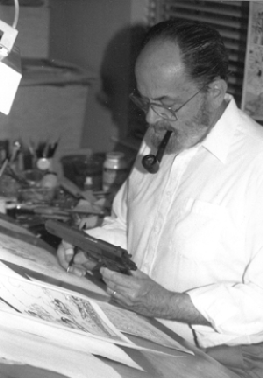
John Powers Severin was an American comics artist noted for his distinctive work with EC Comics, primarily on the war comics Two-Fisted Tales and Frontline Combat; for Marvel Comics, especially its war and Western comics; and for his 45-year stint with the satiric magazine Cracked. He was one of the founding cartoonists of Mad in 1952.
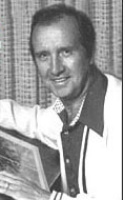
Henry Allan Hartley known professionally as Al Hartley, was an American comic book writer-artist known for his work on Archie Comics, Atlas Comics, and many Christian comics. He received an Inkpot Award at the 1980 San Diego Comic-Con.
Ernest Huntley Hart, also known as H.E. Huntley, was an American comic-book writer and artist best known for creating Marvel Comics' character Super Rabbit as well as co-creating the superhero The Wasp. In addition, he variously wrote, edited and illustrated numerous books on dog breeding and ownership.

Atlas Comics was the 1950s comic-book publishing label that evolved into Marvel Comics. Magazine and paperback novel publisher Martin Goodman, whose business strategy involved having a multitude of corporate entities, used Atlas as the umbrella name for his comic-book division during this time. Atlas evolved out of Goodman's 1940s comic-book division, Timely Comics, and was located on the 14th floor of the Empire State Building. This company is distinct from the 1970s comic-book company, also founded by Goodman, that is known as Atlas/Seaboard Comics.
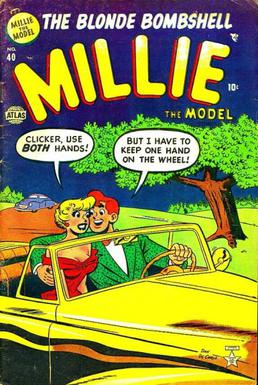
Millie the Model was Marvel Comics' longest-running humor title, first published by the company's 1940s predecessor, Timely Comics, and continuing through its 1950s forerunner, Atlas Comics, to 1970s Marvel. The comic book series deals with Millie Collins, an aspiring model working for the Hanover Modeling Agency.
Morris S. Weiss was an American comic book and comic strip artist and writer. Active from the 1930s through the mid-1970s, he created the teen-comedy character "Margie" for Timely Comics, the 1940s predecessor of Marvel Comics, and was the final cartoonist on the comic strip Mickey Finn. He also worked as a writer or illustrator on numerous other strips, including Joe Palooka.

Ed Winiarski who sometimes signed his work "Win" or "Winny" and sometimes used the pseudonym Fran Miller, his wife's maiden name, was an American comic book writer-artist known for both adventure stories and talking animal cartooning in the late-1930s and 1940s Golden Age of comic books.
Ruth Atkinson Ford, née Ruth Atkinson and a.k.a. R. Atkinson, was an American cartoonist and pioneering female comic book writer-artist who created the long-running Marvel Comics character Millie the Model and co-created Patsy Walker.
Paul S. Newman was an American writer of comic books, comic strips, and books, whose career spanned the 1940s to the 1990s. Credited in the Guinness Book of World Records as the most prolific comic-book writer, with more than 4,100 published stories totaling approximately 36,000 pages, he is otherwise best known for scripting the comic-book series Turok for 26 years.
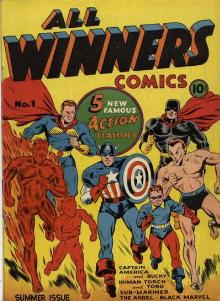
All Winners Comics was the name of two American comic book series of the 1940s, both published by Marvel Comics' predecessor, Timely Comics, during the period fans and historians call the Golden Age of Comic Books. A superhero anthology comic in both cases, they variously featured such star characters as Captain America, the original Human Torch, and the Sub-Mariner. All Winners Comics was also the venue for two full-length stories of Marvel's first superhero team, the (hyphenated) All-Winners Squad.
Alfred J. Gabriele was an American comic book artist during the 1940s period fans and historians call the Golden Age of comic books. He was known for his work on some of Marvel Comics' earliest Captain America and Sub-Mariner stories, and for co-creating the company's superheroes Black Marvel, Miss America, and possibly, the Whizzer.
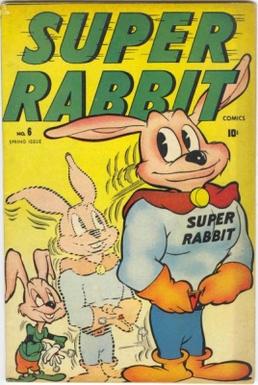
Super Rabbit is a talking animal superhero in american comic books published by Timely Comics, a predecessor of Marvel Comics, during the 1930s and 1940s period fans and historians call the Golden Age of comic books. Created by cartoonist Ernie Hart, he first appeared in Comedy Comics #14.

Ziggy Pig and Silly Seal are fictional, talking animal comic-book characters created by cartoonist Al Jaffee for Marvel Comics' 1940s predecessor, Timely Comics, during the period fans and historians call the Golden Age of Comic Books.

Girl Comics is the name of two comic-book series published by Marvel Comics and its forerunners, Timely Comics and Atlas Comics. The first, debuting in 1949, ran 35 issues, changing its title to Girl Confessions with issue #13. The second was a three-issue limited series published in 2010.
Notable events of 1957 in comics.
Patsy and Hedy is a comic book title featuring the character Patsy Walker originally published by Atlas Comics beginning in 1952 and later by Marvel Comics.
Note at the bottom left of the cover is the Atlas globe, this being the latest month the globe will ever appear (Sept/57) as Goodman lost his distributor when ANC (American News Corp.) crashed in April. There is an October cover month with the globe, the comic book Dippy Duck #1, but this is a clerical anomaly as cover proofs show an original Sept/57 date and the issue was on the stands with August and September cover-dated comics.
In fact, the first true 'Marvel Age' comic — the first issue minus the Atlas symbol in the upper-left corner — was Patsy Walker #73 (Oct. 1957).